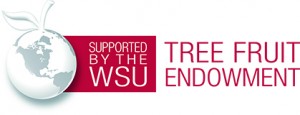Written by Basavaraj Amogi, Lav Khot and Bernardita Sallato. July 2025
Red color in apples
Red pigmentation in Cosmic crisp® apples is crucial for marketability and consumer appeal. While starch levels are used by growers to determine harvest maturity, background color is also relevant and a practical guide for harvest decisions in Cosmic crisp ®. Summer heat waves can delay or even reduce red coloration of maturing fruits, causing delayed harvest timeline, lowering fruit quality and ultimately economic returns.
We studied the impact of different heat stress mitigating practices on fruit color development or red color loss. Below we share main findings from the study in the Journal of Agriculture and Food Research.
Key Findings
- Heat stress (>35°C/95°F) leads to color loss.
- Cool nights (<12°C/54°F) help restore red color.
- Color loss is reversible with micro-climate management during summer heat waves.
| Treatment | Outcome | Cause and effect |
| Fogging | Best color retention | Fine mist reduces heat stress without adverse effect on color progression |
| Netting (15%) | Slower red color development | Netting typically traps heat and during warm nights air temperatures could be > 12°C/54°F; needed for color development |
| Untreated Control | Severe color loss | No protection from heat or sunburn |
Note: These impacts are most pronounced during heat waves. Consecutive days with daytime temperatures above 35 °C (95 °F) and unusually warm nights.
We continually monitored fruits using visible imagery, of crop physiology sensing system deployed in the treatment block. This imagery was used to estimate Hue Angle (h°), Color Intensity (a*), and Chroma/Vividness (C*).
- Hue Angle (h°): Lower = redder fruit
- Fogging: Maintained red coloration (h° ~ 345°)
- Netting & Untreated Control: Shifted to yellow/green (h° > 90°)
- Color Intensity (a*) & Chroma/Vividness (C*):
- Fogging: High a* and C* = vibrant red
- Untreated control: a* near zero = dull, pale fruit
- Examples of color progression during heat wave

Recommendations
- Use fogging or over-tree cooling to keep fruit temperature(s) below sunburn threshold during heat wave.
- Monitor actual canopy/fruit temperatures, do not overly on just nearby weather stations.
- Be cautious with permanent netting — consider retractable systems.
- Night temperatures below 12°C/54°F are critical for color recovery.
- Use real-time sensors to make informed irrigation and heat stress mitigation decisions.
Overall, effective and adequate summer heat stress mitigation enhances red coloration, fruit quality, and market value in Cosmic Crisp® apples. Among the strategies tested, fogging proved to be the most effective. Note: Although not included in this study, overhead cooling may yield comparable results to fogging.

